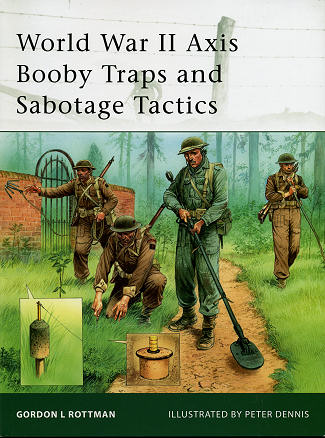 The
use of munitions to cause damage to personnel is as old as gunpowder. However it
wasn't until the 17th and 18th century that weapons were rigged to specifically
work as booby traps. The booby trap has been around even longer when ancient
humans used them to trap animals. Often just a pit with a covering, it has grown
over the centuries to be used more and more against soldiers in a time of war.
The IED's of Iraq and Afghanistan are the current use of these devices.
The
use of munitions to cause damage to personnel is as old as gunpowder. However it
wasn't until the 17th and 18th century that weapons were rigged to specifically
work as booby traps. The booby trap has been around even longer when ancient
humans used them to trap animals. Often just a pit with a covering, it has grown
over the centuries to be used more and more against soldiers in a time of war.
The IED's of Iraq and Afghanistan are the current use of these devices.
The greatest use of booby traps was in WWI, but those have
often been overshadowed by the greater carnage caused by trench warfare. During
WWII, all of the fighting powers used these to some extent, but none were as
good at it as the Germans. The level of ingenuity in setting up these devices is
such that finding them and disarming them was not at all an easy task.
Booby traps were designed more to injure an opponent than it
was to kill them. A dead man needs no additional help, while an injured one will
take at least one of his comrades if not more, to help him back to medical aid,
thus reducing the effective fighting force. The other benefit to these traps is
that it makes the rest of the unit that much more wary and can easily slow the
pace of advance.
Booby traps are most often combined with mines or grenades to
provide the explosion needed. These were set off by trip wires, pull wires, or
pressure. Traps were hidden in areas least expected or were rigged to abandon
weapons. Even simple things as a drawer or door could be set up with a booby
trap.
In this book, author Rottman looks at the history of booby
traps and especially their use in WWII. Both German and Japanese traps are
covered. Then there is a look at the materials used in making a trap, specific
German types, and some of the sabotage devices used by the Wehrmacht. Then there
is a smaller section on Japanese booby traps and the impact of these devices on
advancing troops.
Much of this material comes from regular reports and
bulletins released by the British and American armies on the subject. These
reports cover the basics of the traps and new trap designs that had been found
since the last report. This is combined with photos of these devices as well as
drawings taken from the reports. The illustrations of Peter Dennis also some
some of these traps in combat situations and ways used to detect them.
In all, it is another fascinating Osprey title on a subject
that we all know about to some extent. Now all of that information is in one
place in a book that is highly readable and quite interesting. One I know that
you will enjoy.
August 2009
For more on the complete line of Osprey books,
visit www.ospreypublishing.com. In the US, it is
Osprey Direct at 44-02 23rd St, Suite 219, Long Island City, NY 11101., where you can
get a catalogue of available books.
If you would like your product reviewed fairly and quickly, please contact
me or see other details in the Note to
Contributors.
 The
use of munitions to cause damage to personnel is as old as gunpowder. However it
wasn't until the 17th and 18th century that weapons were rigged to specifically
work as booby traps. The booby trap has been around even longer when ancient
humans used them to trap animals. Often just a pit with a covering, it has grown
over the centuries to be used more and more against soldiers in a time of war.
The IED's of Iraq and Afghanistan are the current use of these devices.
The
use of munitions to cause damage to personnel is as old as gunpowder. However it
wasn't until the 17th and 18th century that weapons were rigged to specifically
work as booby traps. The booby trap has been around even longer when ancient
humans used them to trap animals. Often just a pit with a covering, it has grown
over the centuries to be used more and more against soldiers in a time of war.
The IED's of Iraq and Afghanistan are the current use of these devices.